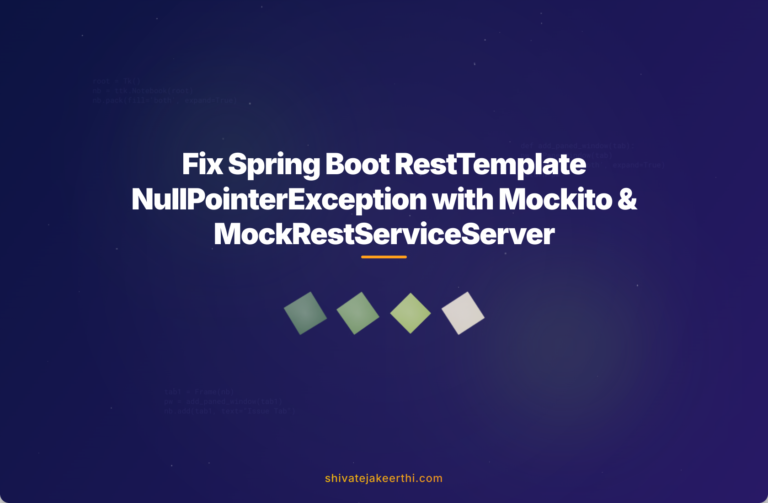Spring Boot simplifies the development of robust Java applications, offering handy tools and integrations for seamless testing. However, even seasoned developers encounter common pitfalls, such as the notorious NullPointerException during unit testing with RestTemplate. This issue frequently pops up when developers attempt to test methods interacting with external resources. So, let’s explore why this happens and how we can effectively resolve it.
Why are You Facing a NullPointerException?
Most developers have encountered a NullPointerException at least once. It’s a runtime exception in Java thrown when an application tries to use an object reference still not assigned to an instance, essentially “null.”
In Spring Boot tests, this can happen when the RestTemplate dependency is not correctly instantiated or mocked, causing test cases to reference uninitialized objects. Suppose you have this typical snippet in your service class:
@Autowired
private RestTemplate restTemplate;
public String getUserDetails(int userId) {
ResponseEntity response = restTemplate.getForEntity("http://userapi/users/" + userId, String.class);
return response.getBody();
}
When you attempt to run unit tests on such methods without mocking the RestTemplate, you get greeted with an unwelcome NullPointerException because your test doesn’t know how to handle this external call yet.
Using Mocking to Solve the NullPointerException
Testing code that interacts with external services or APIs presents numerous challenges. Thankfully, mocking provides a practical solution for isolating your code from external dependencies, allowing tests to run independently and predictably.
Mocking frameworks such as Mockito offer powerful capabilities to create mock objects. Leveraging Mockito ensures your tests behave consistently, even without actual external calls. Mockito seamlessly integrates with Spring Boot’s test capabilities, greatly simplifying your test setup.
Mocking RestTemplate Using @MockBean
The first strategy to mock RestTemplate behavior effortlessly in Spring Boot is employing the @MockBean annotation. It’s a special annotation provided by Spring Boot specifically for mocking beans, making external calls predictable and testable.
Here’s a simple way to mock RestTemplate using @MockBean:
@RunWith(SpringRunner.class)
@SpringBootTest
public class UserServiceTest {
@Autowired
private UserService userService;
@MockBean
private RestTemplate restTemplate;
@Test
public void getUserDetailsTest_Success() {
int userId = 101;
String mockResponse = "{\"name\": \"John Doe\", \"email\": \"john@example.com\"}";
ResponseEntity mockEntity = new ResponseEntity<>(mockResponse, HttpStatus.OK);
Mockito.when(restTemplate.getForEntity("http://userapi/users/" + userId, String.class))
.thenReturn(mockEntity);
String result = userService.getUserDetails(userId);
assertNotNull(result);
assertEquals(mockResponse, result);
}
}
In the test above, we mocked the RestTemplate to return a predefined response, eliminating the need for a real HTTP call and preventing a NullPointerException.
Further Simplify Testing with MockRestServiceServer
In cases where fine-grained control of mocking HTTP responses is needed, Spring offers another cool tool—MockRestServiceServer. This utility is designed explicitly for testing RestTemplate interactions, giving greater flexibility in defining and handling expected HTTP calls.
Here’s how you can use MockRestServiceServer for the same kind of test:
@RunWith(SpringRunner.class)
@SpringBootTest
public class UserServiceTest {
@Autowired
private UserService userService;
@Autowired
private RestTemplate restTemplate;
private MockRestServiceServer mockServer;
@Before
public void setUp() {
mockServer = MockRestServiceServer.createServer(restTemplate);
}
@Test
public void getUserDetailsTest_WithMockServer() {
int userId = 101;
String mockResponse = "{\"name\": \"John Doe\", \"email\": \"john@example.com\"}";
mockServer.expect(ExpectedCount.once(),
requestTo("http://userapi/users/" + userId))
.andExpect(method(HttpMethod.GET))
.andRespond(withSuccess(mockResponse, MediaType.APPLICATION_JSON));
String result = userService.getUserDetails(userId);
assertNotNull(result);
assertEquals(mockResponse, result);
mockServer.verify();
}
}
The MockRestServiceServer validates that your code makes exactly the expected HTTP calls, making it perfect for detailed and accurate validations, alongside avoiding NullPointerExceptions.
Step-by-Step Guide to Eliminating the NullPointerException
Let’s neatly sum up the process of resolving the NullPointerException issue in your Spring Boot test case:
- Identify the Dependency: Check which external resource or service your method uses (like a RestTemplate).
- Write the Test: Use the @MockBean annotation or MockRestServiceServer to simulate the RestTemplate behavior.
- Implement Changes: Include clearly defined mock responses in test cases to prevent null references.
With these simple changes, your tests will now run smoothly, returning precise, mock-driven responses.
Best Practices for Reliable Spring Boot Tests
Thorough and reliable unit tests are essential for lasting software quality. Here are some best practices for creating maintainable and effective Spring Boot tests:
- Isolate Tests: Mock external dependencies like databases or external APIs using Mockito.
- Use JUnit Efficiently: Leverage JUnit annotations and assertions effectively to keep tests concise and clear.
- Clean and Readable: Maintain short, descriptive tests—so anyone on your team can easily understand and maintain them.
Implementing these tips will save your team significant time, helping catch bugs early and ensuring greater confidence when deploying your application.
Spring Boot testing provides excellent opportunities for you to ensure your application behaves as expected, guarding against common pitfalls like NullPointerExceptions. With proper mocking techniques, especially for external dependencies such as RestTemplate, you can easily achieve robust, error-free tests.
By following systematic mocking strategies using @MockBean or MockRestServiceServer, you’ll be on your way toward more productive and satisfying coding sessions.
Before your next Spring Boot testing session, why not revisit your codebase and see if you can further strengthen your tests? Are there other external dependencies you could better isolate? Let’s build resilient, reliable software, one test at a time.



0 Comments